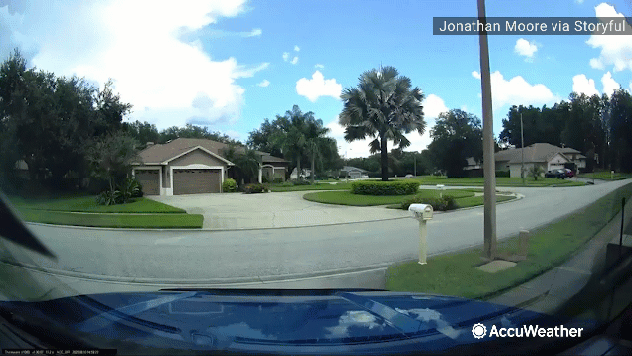This past Monday afternoon, the weather in the Lutz, Florida, area, located about 20 minutes north of Tampa, seemed to be that of a normal summer day in that neck of the Sunshine State.
Typical summertime thunderstorms had been making their way through the Tampa-Saint Petersburg area, but around 4 p.m., the closest storm in the vicinity to Lutz was about 3 miles away. All appeared to be tranquil as puffy white clouds floated across a splendid blue sky. But then something unexpected, and startling, happened.
CLICK HERE FOR THE FREE ACCUWEATHER APP
As captured on dashcam video by Lutz resident Jonathan Moore, a large and booming bolt of lightning dropped out of the blue sky and struck a neighbor’s palm tree across the street with such force that Moore’s dashcam beeped, which it usually does to alert the driver of any type of movement.
“My son just happened to back the truck into the driveway, which pointed the camera right at the tree that got struck,” Moore told AccuWeather National Reporter Jonathan Petramala, explaining how the sensational footage was captured.
The tree was briefly ignited and one limb fell to the ground as a result of the strike. Equally as jarring as the visual image of a lightning bolt crashing to Earth was the sound the strike made, which was also caught in the footage. No injuries were reported.
“It was very sunny out,” Moore recalled. “We knew that in the next hour it was going to storm, but it [the lightning bolt] did come out of the blue.”
Without a thunderstorm directly overhead, it might seem unusual for a lightning strike to occur amid what otherwise appeared to be rather calm weather, but meteorologists say there is a specific reason something like this can occur.
This type of lightning strike has a specific name and is referred to as a “bolt from the blue.” In this particular case, the thunderstorm the bolt came from was about 3 miles away from Lutz’s home, Jesse Ferrell, a meteorologist and senior weather editor for AccuWeather, said.
Ferrell analyzed lightning-strike data provided by Earth Networks on that particular storm to determine the precise location of the storm at the time of the bolt from the blue strike. Earth Networks tracks lightning strikes with a network of lightning sensors. There was no rain in the immediate area either, Ferrell explained, which added to the shock value of the bolt caught by Moore’s dash cam. Rainfall was also about 3 miles away.
  |
Although the storm was 3 miles to the west of Moore’s home, his specific location was underneath what meteorologists refer to as a storm anvil, which can also produce lightning.
“A storm anvil is an elongated cloud that forms on top of a thunderstorm when rising clouds meet the top of the troposphere — the part of the atmosphere that contains the weather — and spread out,” Ferrell explained. Ferrell was able to use graphics to recreate the storm anvil associated with this lightning strike, a visual that can be seen in the video at the top of this article.
A bolt from the blue can also be “a cloud-to-ground strike which comes out of the side of the thunderstorm cloud,” according to the National Severe Storms Laboratory. In this case, it’s not possible to tell whether the bolt came from the storm anvil or out of the side of the thunderstorm cloud, Ferrell said.
AccuWeather Meteorologist Brett Rossio said thunderstorms can become very localized during the peak of summer. “The radial spread of the thunderstorm can end up being only a mile or two,” which Rossio said can lead to someone on the ground “seeing plenty of blue sky.” During this time, pop-up thunderstorms can occur.
That, too, was a phenomenon that led to this bolt from the blue lightning strike. Ferrell said the storm that produced the bolt caught on Moore’s dash cam was very fast-forming, which also added to the element of surprise for anyone who was on the ground near Moore’s home. “The storm had only formed five minutes before the bolt struck,” Ferrell pointed out. “So five minutes before that, it was just a puffy cloud.”
It’s also worth noting that a bolt from the blue can travel much farther from a storm cloud than this one did, which underscores the gravity of the popular safety adage, “When thunder roars, head indoors.” According to NOAA, a bolt can strike as far as 15 miles away from the storm, which can be too far for thunder to be heard.
Ferrell also functions as AccuWeather’s social media manager and over the years — he’s been with the company since the late 1990s — has seen a lot of remarkable weather videos.
“It’s one of the best close-up videos of lightning outside of a storm that I’ve seen, especially from the general public,” Ferrell remarked when asked about how it compares to other viral videos. “The sound is also amazing. Having been that close to several lightning strikes in my life, I can confirm that it’s legitimate, and the data from Earth Networks also proves that.”
So far in 2020, about 12 Americans have been struck and killed by lightning, a total that is below average for mid-August. The 10-year average from 2010 to 2019 in the U.S. is 25 deaths. Over the past 10 years, July has been the deadliest month with an average of eight fatalities, while June and August are tied for second with five.
On average, Florida has more lightning-strike fatalities than any other state, which, over the years, has earned it an ominous reputation as the Lightning Capital of America.
Additional reporting by Jonathan Petramala and Jesse Ferrell.
Keep checking back on AccuWeather.com and stay tuned to the AccuWeather Network on DirecTV, Frontier and Verizon Fios.